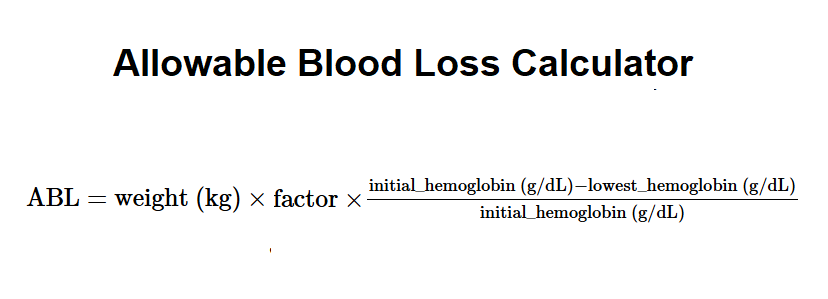 Home
Home
 Back
Back

The Allowable Blood Loss (ABL) Calculator estimates the maximum volume of blood a patient can lose during a procedure before reaching a dangerously low hemoglobin level. The formula used is:
Where:
Select the age/sex category, enter the weight, initial hemoglobin, and lowest acceptable hemoglobin to compute the allowable blood loss in multiple units (ml, L, cups, US gallon).
This calculator is designed to assist healthcare professionals in preoperative planning, estimating how much blood a patient can safely lose before a transfusion might be required, based on age, sex, weight, and hemoglobin levels.
Input the patient’s age/sex category, weight (in g, kg, oz, or lb), initial hemoglobin (g/dL), and lowest acceptable hemoglobin (g/dL). The calculator will display the allowable blood loss in ml, L, cups, and US gallons.
Example: For an adult male weighing 100 kg with initial hemoglobin 100 g/dL and lowest acceptable hemoglobin 10 g/dL:
Use this tool for preoperative assessments, but consult a healthcare provider for clinical decisions and transfusion thresholds.
Allowable Blood Loss is the maximum volume of blood a patient can lose during a procedure before their hemoglobin level drops to a dangerously low level, potentially requiring a transfusion.
ABL varies based on the patient’s blood volume, which depends on age, sex, and weight. For example, adults typically have different blood volumes per kilogram compared to children or neonates.
Normal hemoglobin levels vary by age and sex but generally range from 12-18 g/dL for adults. The lowest acceptable level is typically 7–10 g/dL, depending on clinical guidelines.
This calculator provides an estimate based on standard formulas and typical blood volume factors. For precise medical decisions, consult a healthcare provider.
No, this calculator is specifically designed for blood loss estimation and assumes standard blood density and volume factors. It should not be used for other fluids.